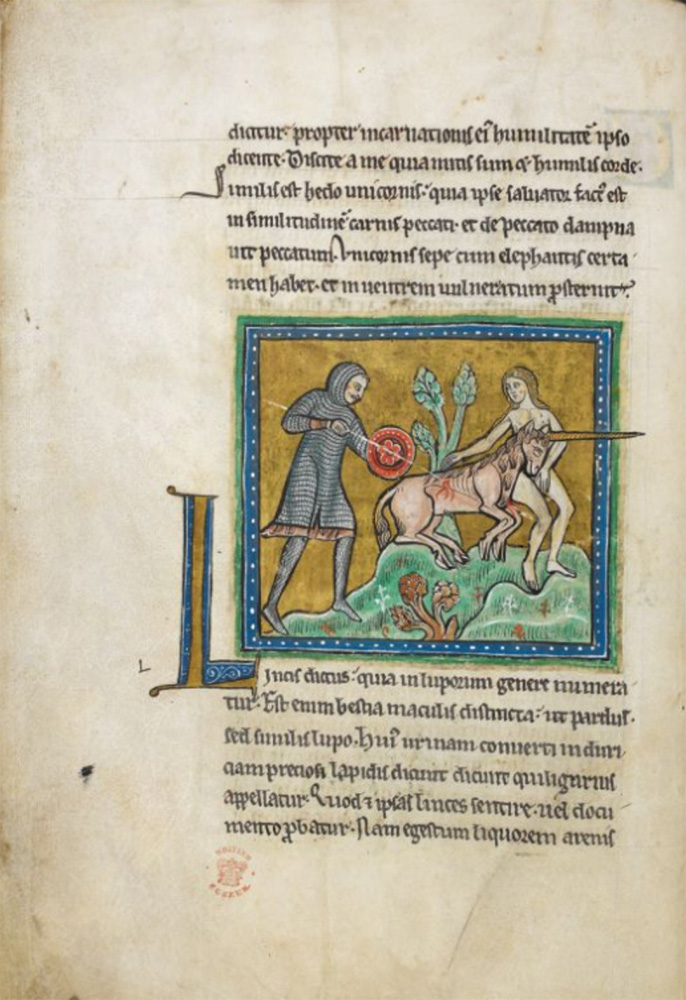British Library, Royal MS 12 F XIII
Rochester Bestiary
Codicology
| Current Location: | British Library, London, England, United Kingdom |
| Shelfmark: | Royal MS 12 F XIII |
| Produced: | England, About 1230 |
| Manuscript Type: | Bestiary |
| Bestiary Family: | Second |
| Language: | Latin |
| Folios: | 152 |
| Illustrated: | Yes |
| Media: | Vellum |
| Script: | Gothic |
| Dimensions: | Height: 30 cm Width: 21.5 cm |
Description
Contains an illustrated Bestiary (folio 3r -141r), in sections:
- Beasts (mostly mammals) - folio 3r-46v (fully illustrated)
- Birds (the Aviary) - folio 46v-88r (illustrated up to folio 50r (vulture), space left for illustrations of remaining birds)
- Serpents and Worms (insects) - folio 88r-102v (space left for illustrations up to folio 99v)
- Fish - folio 103r-112r (space left for illustrations up to folio 107r)
There is a Herbal on folio 112r-123v (ending uncertain) and a Lapidary on folio 141v-149r (neither illustrated). Folio 123v-141v is an unillustrated text beginning Natura dicta....
In many of the illustrations there are animals or birds added to the scene, not obviously related to the beast being illustrated, so probably just decorative. The illustrations usually follow the beast account rather than being above it; the images are therefore not always on the page where the beast is described.
From folio 52r-99v there are spaces left for illustrations that were never completed. The missing illustrations are (folio numbers refer to the space where the image should be): Crane (52r); parrot (52v); caladrius (53v); swan (54v); stork (56r); ibis (57r); coot (58r); ostrich (59v); kingfisher (60v); heron (61r); goose (61v); owl (62r, 63v); phoenix (64r, 65v - blank page possibly reserved for a full page image); cinnamologus (66r); hercinia (66v); hoopoe (67r); pelican (68r); siren (68v); partridge (69r, 70r); turtledove (70v); magpie (71r); hawk (72r); kite (72v); blackbird ? (73r); hoopoe (73v); owl (74r); bat (74v); raven (75r); crow (76r); dove (77r); turtledove (78r); swallow (79r); nightingale (79v); cock (82r); hen (83v); duck (84v); bee (87v - blank page possibly reserved for illustration); peridexion tree (87v); asp (89r); snake (89v); dragon (90v); basilisk (91r); viper (92r); scitalis (92v); amphisbaena (92v); hydrus (93r); hydros (94r); jaculus (94r); boa (94v); seps (95r); dipsa (95r); lizard (95v); salamander (96r); lizard (96v); newt (97r); scorpion (99v); fish (103r); whale (103v); sawfish (104v); dolphin (105v); sea-pig (106r); swordfish (106r); crocodile (106v); torpedo (107r); echeneis (107r).
[From Payne, page 14]
Illustrated with illuminated initials and 55 miniatures in rectangular frames with plain gold grounds. ... The manuscript includes a number of additions from the Pantheologus of Peter of Cornwall... The artist is thought to have worked in the south east of England and an inscription on the first page of the text shows the manuscript once to have belonged to the Benedictine Cathedral Priory of Rochester, Kent.
[Adapted from the British Library catalog]
Bestiary, or moralized Natural History (animals and trees), in Latin. The basis is as usual a combination of the Physiologus with the corresponding parts of the Etymologiae of Isidore of Seville (cf. British Library Royal MS 2 C XII). So far it agrees in the main in contents with British Library Royal MS 12 C XIX, part. 5, and both in order and contents with British Library, Additional MS 11283. Additions seem to originate in the Pantheologus of Peter of Cornwall (Prior of Christchurch, Aldgate, 1197-1221), to which work there are some references (ff. 39, 113), cf. British Library Royal MS 7 C XIII. The first four articles are Leo, Tigris, Pardus, Pantera, and the last two Partes hominis (Aetates hominis omitted) and Lapides igniferi. Beg. 'Bestiarum vocabulum'. f. 3. Appended is a Lapidary in French prose, probably taken from the Latin poem of Marbodus, Bishop of Rennes (d. 1128).
Additional Descriptions
Editions and Facsimiles
Digital facsimiles



